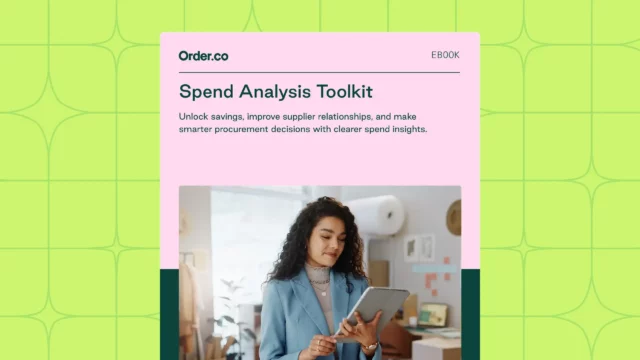The Tactical Tail Spend Playbook: Consolidate Suppliers, Curate Catalogs, and Win Control

The Tactical Tail Spend Playbook: Consolidate Suppliers, Curate Catalogs, and Win Control
Tail spend—the countless small, infrequent purchases that fly under the radar—is one of the biggest challenges for growing businesses. While individually minor, these transactions collectively account for up to 20% of a company’s total spend. Left unmanaged, this long tail of invoices, unapproved vendors, and out-of-policy purchases erodes profitability and ties up finance teams in low-value administrative work.
Winning control requires a clear, actionable strategy. This tactical playbook provides a three-step framework to rein in unmanaged spend. By consolidating suppliers, cleansing data, and guiding user behavior, you can transform tail spend from a source of chaos into a driver of efficiency and cost savings.
Download the free ebook: Spend Analysis Toolkit
What is tail spend (and why is it so hard to manage)?
Tail spend refers to the high volume of low-value purchases that make up approximately 80% of a company’s transactions but only 20% of its total spend value. This includes everything from one-off office supplies and marketing materials to specialized operational goods that fall outside of centrally managed contracts.
The primary challenge of tail spend management is its fragmented nature. These purchases are often made by various employees across different departments and locations, using personal cards, expense reports, or direct invoicing. This decentralization creates several significant problems:
- Lack of visibility: Without a central system, finance and procurement teams have no real-time insight into who is buying what, from whom, or at what price. This makes accurate budgeting and forecasting nearly impossible.
- Maverick spending: Employees frequently purchase from unapproved vendors, pay inconsistent prices, and buy items that don't meet company standards. This maverick spending eliminates negotiating leverage and introduces unnecessary risk.
- Operational inefficiency: The accounts payable team is burdened with processing a massive number of small invoices from hundreds or even thousands of different suppliers. This manual work is time-consuming, expensive, and prone to error.
- Wasted savings opportunities: Because the spend is spread across so many suppliers, companies miss out on volume discounts and the negotiating power that comes from consolidating purchases with preferred vendors.
Bringing order to this chaos requires a systematic approach. The following playbook provides the tactical steps needed to gain control and optimize your indirect purchasing.
The 3-step playbook for effective tail spend management
A successful tail spend management strategy is built on three pillars: visibility, consolidation, and control. This playbook turns those pillars into a repeatable process that any organization can implement to streamline operations and improve its bottom line.
Step 1: Analyze and cleanse your spend data
You can’t control what you can’t see. The first step is to create a single source of truth by aggregating and analyzing your spend data from every source, including ERP systems, credit card statements, expense reports, and accounts payable ledgers.
Start by identifying all sources of purchasing data across your organization. Once you’ve pulled this information into a central location, your goal is to cleanse and categorize it to reveal actionable insights.
- Group similar vendors: Many vendors may appear under different names (e.g., "Staples," "Staples Inc.," "SPLS"). Standardize these entries to get an accurate count of your total vendors and see how much you’re spending with each.
- Categorize purchases: Classify spend into logical groups like "office supplies," "IT hardware," "marketing collateral," and "facilities maintenance." This helps identify which categories have the most suppliers and the highest potential for savings.
- Identify top suppliers by volume: Pinpoint which suppliers account for the highest number of individual transactions, even if the total dollar value is low. This list will be your primary target for consolidation in the next step.
This analysis provides the critical visibility needed to make strategic decisions. It reveals exactly where money is going and highlights the biggest opportunities to consolidate indirect suppliers.
Step 2: Consolidate your indirect suppliers
With clean data in hand, you can begin strategically reducing your vendor count. The goal is to move the majority of your tail spend to a smaller group of preferred, high-performing suppliers without disrupting operations.
This consolidation process builds negotiating leverage and dramatically simplifies procurement and payment workflows.
- Identify consolidation opportunities: Using your categorized spend data, look for areas where multiple suppliers provide similar products. For example, you may find that different teams are buying office supplies from ten different vendors. This is a prime opportunity for consolidation.
- Select preferred suppliers: For each major category, choose one or two strategic partners who can meet the needs of your entire organization. Evaluate potential suppliers based on pricing, product selection, reliability, and customer service.
- Negotiate better terms: By consolidating your purchasing volume with fewer suppliers, you gain significant leverage. Use this to negotiate better pricing, volume discounts, and more favorable payment terms. For example, a procurement platform like Order.co centralizes purchasing across thousands of vendors, giving businesses the collective buying power to save an average of 5% in cash back rewards.
- Communicate the new policy: Once you’ve established your list of preferred suppliers, formalize it in your company’s procurement policy. Clearly communicate these changes to all employees, explaining the benefits of the new, streamlined approach.
Reducing your supplier base is the most effective way to cut down on invoice processing costs and regain control over your procure-to-pay process. Instead of managing thousands of vendor relationships and payments, your AP team can focus on a handful of strategic partners.
Step 3: Curate catalogs and drive user adoption
The final step is to make it easy for employees to do the right thing. Even the best-laid plans will fail if the purchasing process is confusing or restrictive. To reduce maverick spend for good, you must provide a user-friendly buying experience that guides employees to the right products from the right suppliers.
The most effective way to do this is by implementing a tail spend software solution with curated catalogs.
- Build curated catalogs: Instead of letting employees browse endless options online, create pre-approved product lists within a centralized purchasing system. A curated catalog ensures that every purchase is on-brand, in-budget, and compliant with company policy. This is a core function of the Order.co platform, which makes outdated punchout systems obsolete by creating one unified catalog for all vendors.
- Automate approval workflows: Set up rules that automatically route purchase requests to the appropriate manager for approval based on factors like cost, department, or product category. This eliminates bottlenecks and ensures every purchase has proper oversight before it’s made.
- Prioritize the user experience: The new purchasing system should be as simple and intuitive as shopping on a consumer website. If it’s easier for an employee to buy from an unapproved source than to use the official system, rogue spend will continue. A positive user experience is critical for adoption.
By channeling all purchasing through a guided marketplace, you embed control at the very start of the process—the point of purchase. This ensures 100% user adoption and eliminates the possibility of out-of-policy spending.
Choosing the right tail spend software to automate your playbook
Executing this playbook manually is possible for small companies, but it doesn’t scale. As your business grows, the volume and complexity of tail spend require a dedicated technology solution. The right tail spend software automates each step of the playbook, from analysis to control.
When evaluating spend management solutions, look for a platform that unifies the entire purchase-to-pay process. While many tools offer point solutions for cards, expenses, or AP, true control comes from addressing spend at its origin.
Key features to look for include:
- A unified marketplace: The ability to bring every vendor—online, offline, local, and national—into one centralized platform for ordering.
- Curated catalogs: Tools to build and manage lists of pre-approved products to guide employee purchasing and enforce brand standards.
- Automated approval workflows: Customizable rules to ensure every purchase request receives the proper sign-off before an order is placed.
- Real-time spend visibility: Dashboards and analytics that provide line-level insight into all purchasing activity across every team, location, and vendor.
- Consolidated invoicing: A system that automates payments to all of your vendors and provides your AP team with weekly or monthly consolidated invoices.
These features work together to create a controlled purchasing environment that is both compliant and user-friendly.
How Order.co puts your tail spend playbook into action
Order.co is the only finance and procurement automation platform designed to simplify the entire purchasing lifecycle, making it the ideal engine to power your tail spend management playbook. It centralizes every vendor and transaction into a single, AI-powered system, delivering the visibility and control needed to eliminate waste and scale with confidence.
Here’s how Order.co platform aligns with the three-step playbook:
- Analyze and cleanse data: Order.co provides 100% real-time spend visibility from the moment you start. Every transaction is automatically captured, categorized, and coded to the GL, giving you clean, actionable data to identify savings opportunities from day one.
- Consolidate suppliers: With Order.co, you can manage purchasing from over 15,000 vendors in one place. The platform enables strategic centralized purchasing, while our AI-powered sourcing tools automatically benchmark prices to ensure you’re always getting the best deal. Order.co pays your vendors on your behalf Net 1, and delivers consolidated weekly or monthly invoices, reducing your AP workload by 80%.
- Curate catalogs and drive adoption: Order.co’s unified catalog makes it simple to create lists of approved products for each team and location. The intuitive, marketplace-style experience encourages adoption and guarantees compliance, making maverick spending a challenge of the past.
Don't let tail spend silently drain your resources. By implementing this playbook with a powerful automation platform, you can bring order to the chaos, unlock significant cost savings, and free your team to focus on strategic growth.
Ready to see how Order.co can simplify buying and automate payments for your business? Schedule a demo today.
Get started
Schedule a demo to see how Order.co can simplify buying for your business.
"*" indicates required fields



